#accessible studyblr
Text
Random writing tips that my history professor just told during class that are actually helpful
Download all your sources or print them so you can turn off your wifi
Give your phone to someone
Just. WRITE. Writing is analysing, you’ll get more ideas as you write. It doesn’t need to be perfect, for now you can just blurt out words and ideas randomly. You can fix it later.
Create a skeleton/structure before writing.
Stop before you get exhausted. It’s best to stop writing when you still have some energy and inspiration left, this will also motivate you to get started again next time.
Make a to do list
Work in bite sizes. Even if it’s not much, as long as you put some ideas on paper or do some editing.
Simple language =/= boring language, simple language = clear language.
Own your words. If they are not your words, state this clearly in the text, not just in the footnotes.
STOP BEFORE YOU GET EXHAUSTED. Listing it again because it’s easily one of the best tips a teacher has ever given me.
#ive been studying for 4 years and rarely has a teacher actually given productivity tips#thank you Lies.#history student#history studyblr#essay writing#writing tips#history tips#paper writing#study blog#studyblr#adhd#neurospicy#university#college#study with adhd#study motivation#academia#studyspo#please normalise teaching students how to be productive#make studying accessible#accessibility
14K notes
·
View notes
Text
Wix Learn's Free Web Accessibility Certification | Resources ✨

Hiya! 💗 Today, I stumbled upon an absolute gem that I wanted to share with all of you. If you're learning about web design and inclusivity as I am, this is something you might want to look into~!
Introducing the Web Accessibility Course by Wix Learn - a game-changer for anyone striving to create websites that cater to all users, regardless of impairments. This comprehensive course covers everything you need to know to build an inclusive online space that leaves no one behind. AND IT COMES WITH AN EXAM AND CERTIFICATE (all free too hehe).
In this course, you'll gain mastery over essential skills, including:
🌐 Creating Inclusive Sites: Learn the best practices to make your websites accessible to people with various impairments, ensuring equal access for everyone.
📚 Accessible Title Tags and Headings: Dive into the world of proper title tags and heading structures, making navigation a breeze for every visitor.
👁️🗨️ Crafting Alt Text and Alternative Media: Discover the art of writing meaningful alt text and incorporating alternative media, providing a seamless experience for those with visual challenges.
⚙️ Optimizing Navigation for Assisted Technology Users: Enhance site navigation for individuals relying on assisted technologies, making their browsing experience smooth and efficient.
💬 The Power of an Accessibility Statement: Learn to create a compelling accessibility statement, showcasing your dedication to inclusivity and informing visitors about your website's accessibility features.
They even have prep courses for the exam! 🤗✨
Here's the link to the course: LINK
Hope this helps someone out there, I will be trying it out and seeing how it goes! 👍🏾
#resources#web accessibility#coding#codeblr#programming#progblr#studyblr#studying#tech#software developer#comp sci#programmer#learning to code#webdesign#web design#web development
284 notes
·
View notes
Text

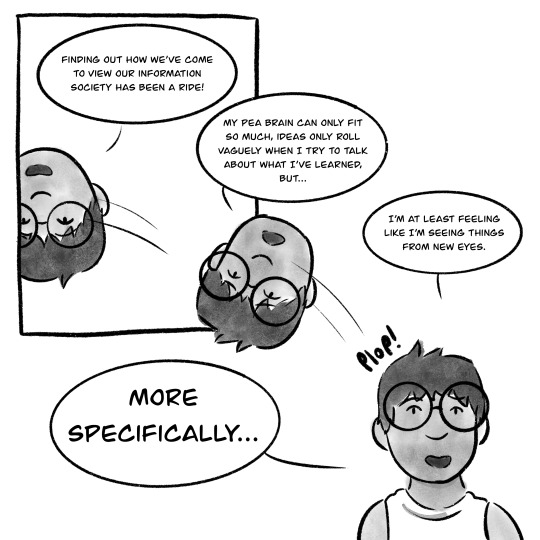
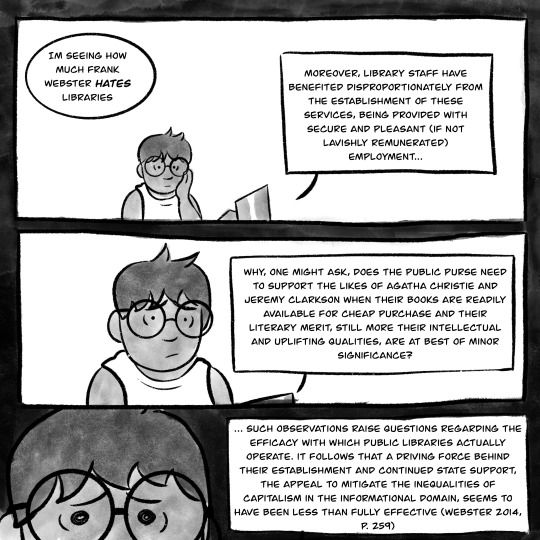

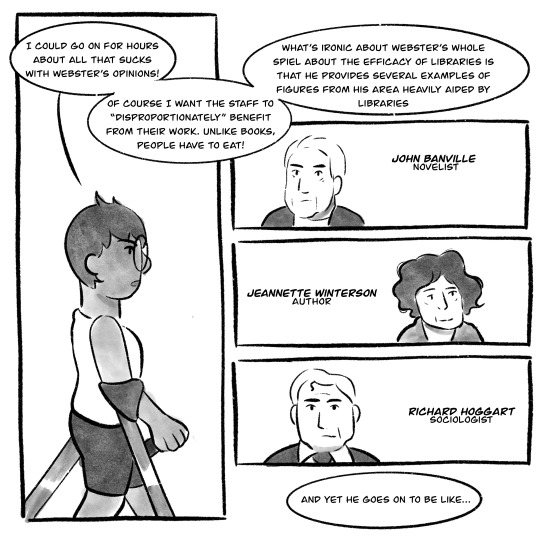

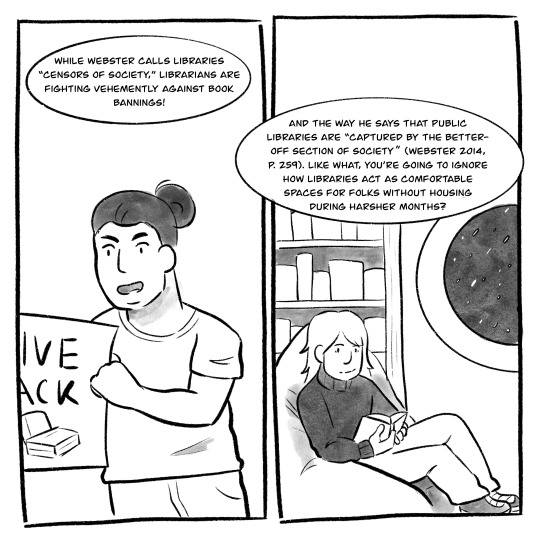



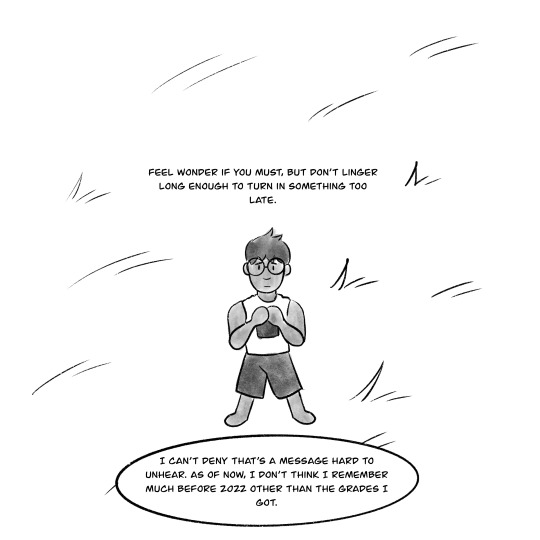
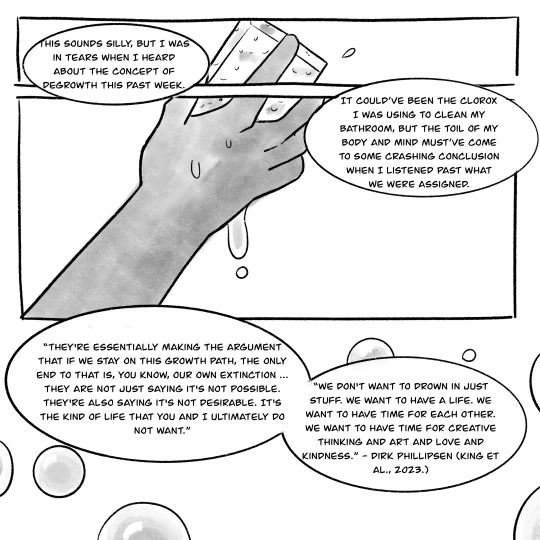
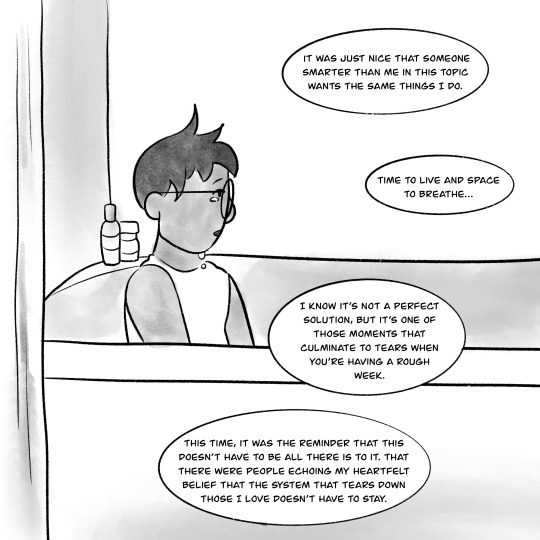


Worth Existing (or, Frank Webster Gives Keegan An Existential Crisis)
been busy this semester, but have a reflection comic I got away with making for an information history class! it's rambling, but i had some fun digesting my thoughts.
image descriptions from alt: The title page contains the title “Worth Existing, or: Frank Webster gives Keegan an existential crisis.” In front of a mirror, Keegan stands with their back facing the viewer as a reflection of them as a librarian looks back worriedly.
Page 1 features a sequential cartoonish sequence of Keegan’s head rolling and landing on his shoulders. He says: “Finding out how we’ve come to view our information society has been a ride. My pea brain can only fit so much, ideas only roll vaguely when I try to talk about what I’ve learned, but I’m at least seeing things from new eyes. More specifically…”
Dialogue continues on Page 2, 3 panels sequentially zoom in on a horrified Keegan. She says, “I’m seeing how much Frank Webster hates libraries.” The quote from the book she’s reading is as follows: “Moreover, library staff have benefited disproportionately from the establishment of these services, being provided with secure and pleasant (if not lavishly remunerated) employment. Why, one might ask, does the public purse need to support the likes of Agatha Christie and Jeremy Clarkson when their books are readily available for cheap purchase and their literary merit, still more their intellectual and uplifting qualities, are at best of minor significance. Such observations raise questions regarding the efficacy with which public libraries actually operate. It follows that a driving force behind their establishment and continued state support, the appeal to mitigate the inequalities of capitalism in the informational domain, seems to have been less than fully effective.” End quote.
Page 3 has Keegan looking with hands clasped, paused. They then look at the camera, asking “Did the dude just insult Agatha Christie?” The bottom has them lying on their bed, looking up at the ceiling in thought, saying “There’s something that just bugged me ever since I read that chapter. I never really understood the theory we talked about in class, it’s a skill I’m working on, but the weird beef he has with libraries at least gave me a vibe on ‘Hayekian Neoliberalism.’ And also how weird it is that capitalism got so far into deciding what’s worth existing. If the thing I wanna do with my life is worth existing.”
On Page 4, Keegan walks with his crutches as the dialogue continues. “I could go on for hours about all that sucks with Webster’s opinions! Of course I want the staff to ‘disproportionately’ benefit from their work. Unlike books, people have to eat! What’s ironic about Webster’s whole spiel about the efficacy of libraries is that he provides several examples of figures from his area heavily aided by libraries. Panels feature novelist John Banville, author Jeannette Winterson, and sociologist Richard Hoggart. Keegan continues and says, “And yet he goes on to be like…”
Page 5, a sock puppet speaks angrily: “People are getting free books and are hurting the poor bookseller! Libraries are stupid because it doesn’t miraculously fix the inequalities of capitalism!” To the side, the text says “Artist’s exaggeration. Don’t take this seriously.” Bottom panel contains Keegan pointing with her thumb at Frank Webster’s Wikipedia page. She says, “I wouldn’t be so hung up if this was some random guy, but considering this guy is so largely quoted and touted in my field of information sciences? Ouch obviously doesn’t cut how much all that stung.”
Page 6 contains an Asian man with a bun protesting banned books. The next panel contains a white woman with a turtleneck reading in a library as a winter storm brews outside. Keegan off-screen says, “While Webster calls libraries ‘censors of society,’ librarians are fighting vehemently against book bannings! And the way he says that public libraries are ‘captured by the better-off section of society?’ Like what, you’re going to ignore how libraries act as comfortable spaces for folks without housing during harsher months?”
On Page 7 a gavel bangs on a panel. “As if that’s not enough, publishers are suing libraries for distributing e-books, calling them ‘direct economic competitors’ when, if anything, they often support these publishers and their authors by buying multiple copies, hosting events and collaborating with local businesses.” As an example, the comic features a scene of a Black woman in a cardigan talking to a white cashier with a shaved head. She says to them, “I just read this at my library earlier and just needed to get my own copy! Can’t believe it took me this long to discover this author!” A panel below, a pair of hands scoops sand and watches it flow from their fingers. Keegan says, “I don’t know. Even in good company, it sometimes feels like the future is slipping through my fingers.”
Page 8 is a pillar of falling sand. Embedded in it is an Apple pencil, a floating feather, and a book. Keegan narrates, “As an artist and a writer, it’s wondering if I’ll be prioritized over a generative AI that doesn’t have to eat or sleep. As a birder, it’s wondering if the backyard visitors I always see at my feeder will end up as myths and taxidermied specimens. As a librarian, it’s wondering if the institutions I often called home will be felled by the swift axe that the invisible hand holds. It’s a weird feeling of perpetual free fall for a drop that is light years away.”
Page 9, Keegan is holding a book to the sky as they read it. They narrate “Learning is a language I’ve always used to make sense of the thoughts I’ve had swirling in my brain. Finding out ‘information capitalism’ was a thing was like learning about the leash that has pulled at my throat since I entered the schooling system. I am learning because I am not a person, but a tool to be put to a trade. The world around me whispers in my ear…”
“Feel wonder if you must, but don’t linger long enough to turn in something too late.” On page 10, Keegan lies on a grassy field looking up with the book on his chest. He narrates, “I can’t deny that’s a message hard to unhear. As of now, I don’t think I remember much before 2022 other than the grades I got.”
On page 11, a hand wipes a bathroom wall with a sponge. The bottom of the page is filled with floating bubbles. Keegan narrates, “This sounds silly, but I was in tears when I heard about the concept of degrowth this past week. It could’ve been the clorox I was using to clean my bathroom, but the toil of my body and mind must’ve come to some crashing conclusion when I listened past what we were assigned.” The quote goes, They’re essentially making the argument that if we stay on this growth path, the only end to that is, you know, our own extinction. They are not just saying it’s not possible. They’re also saying it’s not desirable. It’s the kind of life that you and I ultimately do not want. We don’t want to drown in just stuff. We want to have a life. We want to have time for each other. We want to have time for creative thinking and art and love and kindness.” The quote ends. It comes from Vox’s Blame Capitalism: Degrowing Pains and is spoken by Dirk Phillipsen.
On page 12, Keegan sits in the bathtub with a few tears. Narration goes, “It was just nice that someone smarter than me in this topic wants the same things I do. Time to live and space to breathe. I know it’s not a perfect solution, but it’s one of those moments that culminate to tears when you’re having a rough week. This time, it was the reminder that this doesn’t have to be all there is to it. That there were people echoing my heartfelt belief that the system that tears down those I love doesn’t have to stay.
Page 13. A frog and toad book. “One-sided beef with Frank Webster aside, this unit has bolstered my love for librarianship. As hastily made and rambling this comic went, I realize I feel this strongly because I love this field so much. Against all odds, even as the internet grew to commodify knowledge, libraries adapted to the best of their abilities for their patrons. Why should some British dude make me wonder if libraries will continue to exist? As depressing as learning about capitalism gets, it’s helpful to understand the hand that takes from you. To understand why and how I’ve always been hurt by the systems that be and make sure I can lighten the blow for those who come after. I’ve learned there’s a lot that can come out of being so sad and scared about the future. Sometimes drawing it out (even if you turn in a late assignment) reminds you that there’s still so much ahead. That, and the fact I should probably read Frog and Toad sometime. So, uh, I’m gonna do that now. Bye!"
The references page lists several sources: Frank Webster’s “Theories of the Information Society.” An article by Brewster Kahle called, “The US library system, once the best in the world, faces death by a thousand cuts.” An article by Rachel Kramer Bussel called, “How Libraries Help Authors Boost Book Sales.” And a podcast episode from Vox’s Today Explained hosted by Noel King, titled “Blame Capitalism: Degrowing Pains.” end descriptions.
#art#artists on tumblr#comic#information science#academia#studyblr#library#libraries#library science#image described#image description in alt#accessible art#long post
58 notes
·
View notes
Text
studyblr fairies where can i get free access to academic journals asking for myself
#jstor my beloved#if you've been to uni you should get lifetime access to academic journals#but alas#pls do help i'm trying to write a novel or whatever#op#studyblr#studying#studyspo#study motivation
11 notes
·
View notes
Text
Needa know ! RB to boost pls friend <3
#i need to know for science#bujo#productivity#studyblr#planning#plannerblr#codeblr#tumblr polls#polls#coding#progblr#adhd#autism#accessibility#disability#actually adhd#actually autistic#mentally ill#mental illness#anxiety#depression#studying#study aesthetic#study blog#bullet journal#studygram#adhd brain#adhd stuff#actuallyautistic#neurodivergent
49 notes
·
View notes
Text
Those moments when you're in too much pain to do anything so you stick on music in your target language in the hopes of at least getting something out of the day
#ash’s originals#disabled studyblr#spoonie studyblr#i fucking hate this#Stupid fucking stairs in the new “accessible” building#For fucks sake#Ignore my screaming in the tags because I haven't felt like an actual human being or even been able to think properly or breath for 24 hrs#I HATE this
4 notes
·
View notes
Text
work for the week (25-30 August)
readings:
Ch. 1 for plant morphology (done Aug 25)
Ch. 1 for sensory ecology (done Aug 26)
Ch. 6-7 for thesis class (done Aug 27)
Robertson article for environmental sustainability (done Aug 27)
articles for philosophy of science (done Aug 29)
Ch. 1 for philosophy of science (done Aug 29)
assignments:
second draft of introduction for thesis (done Aug 30)
baseline assessment for plant morphology (done Aug 26)
obligations:
fellowship meeting (done Aug 28)
mentor program introductions (moved to next week)
lab meeting (done Aug 30)
thesis meeting (done Aug 29)
tutor staff meeting (done Aug 30)
#in a day#the academy#studyblr#i'll be editing as I complete each of these :)#and reblog at the end of the week#I'm still missing a syllabus as well so. that may add a couple things once I get access#syllabus obtained there is so much reading for this class sldkfjskl
2 notes
·
View notes
Text
-:✧Finding Sources✧:-
"You have brains in your head. You have feet in your shoes. You can steer yourself in any direction you choose. You’re on your own. And you know what you know. You are the guy who’ll decide where to go."
- Dr. Seuss.
The internet is a very large place, and countless times you’ll hear people telling you to do your own research. However, informational literacy is hard enough without even knowing what to look for in a source, let alone how to read it.
What to Look for in a Source
There are a few good things to look for in a credible and reputable source. As can be inferred from the meaning of credible and reputable, a credible source is going to come from someone or something that is worthy of confidence, and a reputable source is going to be one that has a good reputation.
Peer Review in Academia
Peer review is the review of a scientific study, academic paper, or similar article by other members of their field with similar or greater credentials. The paper clears several other people who are actively trying to dash the hopes and dreams of the author by finding flaws with their design and reasoning. I mostly kid, but it is a rigorous process that results in the paper being as high a quality as it can be.
Journals
Academic Journals are periodical publications where the most recent scholarship on a subject are routinely published. Often these are shortened to just “journals” or otherwise known as “scholarly journals”, “scientific journals”, or “peer reviewed Journals” These are peer reviewed before being included, and themselves often a good place to search for information.
If a source you find has been published in a journal, you’re in incredibly safe territory for reliable sources! There might be competing information from other scholars to review on the subject, but not only do these publications often include more reading material on the subject cited within, they are often followed by links to others who have cited them in their own writing on the subject.
University Publications
University Publications are also very safe places to look for sources. While not themselves always a research paper, they are often the culmination of the knowledge that the university has gathered and reflect the most recent scholarship on a topic; least they risk making the university look bad. These are sometimes found on a university’s website, in a professor's online class notes, a textbook, or similar writing linked to someone in the field.
Primary Sources
Primary sources are often the gold standard for knowledge on a subject, assuming you can find something that qualifies. However, these are often hard to untangle as they can be dense, old, difficult to read or understand (and compared to an academic paper that’s saying something!) assuming they’re even in a language the reader understands.
Where to Find Sources
There are a number of places to find good sources. A quick search engine check can do wonders, however they can be a whole mess, and even knowing what you’re looking for, they can make it harder to find good quality in the sheer volume.
Research search engines and open source libraries can make this process much easier. Google Scholar and JSTOR are good options, and if you’re really in a pinch you can look at Wikipedia. Many will tell you up and down that Wikipedia isn’t a credible source, but while there is some truth to that, you can click the numbers on the information you want to see the sources at the bottom of a Wikipedia page. You can check these sources individually to see how you feel about them. Wikipedia also has a “Talk” section where the contributors discuss what should be on each page that sometimes has additional sources or information that was not included.
How to Get a Library Card
Please go to your local library! Most likely the librarian will be able to help you. You can also check the website of your local library to see if you can sign up. Often libraries will either have books on the subjects that interest you, or may even be able to order them for their collection. Libraries have also started providing eBooks and other technological services. If this is an option for you, it is highly suggested!
University Library Access
Students at most universities are automatically enrolled into the university’s library system. These people can careen around a paywall like it’s a sliding glass door between you and your dreams, and they have the keycard. Find them, ask them, it only takes like 2 minutes of their time to download and send you whatever file you can’t get, especially if you link it directly.
Non-Academic Sources If you’re at your wits end and the only options for sources are news articles, blogs, or websites this isn’t necessarily a bad thing. If this is a personal account of someone’s experience this can be a good thing! Take extra care with these and see if you can’t find multiple sources saying the same thing. If something is true, most likely you’re going to find multiple people saying the same thing in different ways. However, if you do find multiple sources, look to make sure they aren’t just citing or copying one another in a hellish circle of plagiarism.
#studyblr#acadamia#sourcing#university#school of roses#information accessibility#witchcraft#magic#witchy#witchblr#basics#witch tips#witches#baby witch#how to find sources#Come check us out on Discord!#Link is in the pinned post!#public libraries#primary sources#peer review#academic journals#research#doing your own research#long post#a second post on how to better /read/ academic journals should be posted later this week!#enjoy
67 notes
·
View notes
Text
life update!
So.... I've had a bit of an education nightmare the past couple of years. I went from a straight A* student to dropping out of sixth form due to health issues.
BUT-
I went to a college open day this morning to find out about their Access to Science course (basically an intensive fast-track qualification worth 3 A-Levels) and they pretty much gave me an offer on the spot?? Thinking back to how awful my mental and physical health were last year and now I could be going to uni only 2 years later. Everyone was super lovely as well and I got to meet with some of the staff about my additional needs and accommodations and such.
Bit of a self-indulgent post but I am super excited! If i decide I can manage the course I can get a grant from the local council and go back to education in just under a year!!
In the meantime just working on pacing myself and building up a tolerance to activity through volunteering - maybe I'll even be able to get a paying job and save a bit of money before I go back to school!!
15 notes
·
View notes
Text
It would be so cool if my bio professor would make her tests takable. How do you use a software to teach ur entire class but you can’t use the fucking software properly. My exam started half an hour ago why can I not open it!!
#the man at the access center is very nice tho#and very upset on my behalf#studyblr#study aesthetic#studyinspo#study motivation#studyspo
4 notes
·
View notes
Text
Learn Web Accessibility | Resources ✨

Web.Dev has a section called "Learn Accessibility" that talks about how to make your websites and code more accessible for others!
>> Link to Learn Accessibility - Web.Dev
#resources#coding resources#studying#programming#coding#studyblr#codeblr#progblr#comp sci#html5#html#web dev#web accessibility#accessibility#web development
342 notes
·
View notes
Text
✒ Planning...for the Neurodivergent!
I think that for most people the term "planning" conjures pictures of perfectly executed layouts and neat, tidy handwriting. While these things are certainly impressive, sometimes it feels like it prioritizes style over function. Journaling, and by extension, planning, does NOT have to be expensive, time consuming, or perfect.
When I first started dipping my toes into the community a few years ago, I got probably two weeks into a proper “bullet journal” before I gave up. My ink smudged, my stickers peeled, and I found that spending hours making the perfect layout was sucking away my limited time.
As a newly diagnosed and treated ADHD-er, I have found some success in a printed planner. All the months, weeks, and days are already laid out for me, and I have the time at work to fill out everything I need.
But what about someone who doesn’t have the luxury of down time at work? What about someone who gets overwhelmed just THINKING about all of the long-term projects and obligations they have on a day-to-day basis? A chronic procrastinator? Someone whose phone’s to-do list is just BURSTING with tasks, but there’s no prioritization?
Introducing…the pocket notebook!
The main objective of this is to find a pocket notebook that is portable, slim, and enjoyable to write on. Field Notes are quite popular among the stationery crowd, but they’re also on the pricey side for only 48 pages. If you have the money and you enjoy them, go for it! But there could very well be something just as perfect for you waiting at the dollar store.

Yeah, it’s small, and therefore may not be the most comfortable thing to write in. However, it’s not truly meant to be a full-blown journal. No– instead of shoving it into an endless to-do list or note on your phone…you are making your idea tangible.
Your phone, and by extension all of its notifications and applications and features, is designed to distract you. By removing all of that and placing a simple, analog tool in front of you…it is, in theory, easier to focus on what matters.
Think of a cool story idea at work? Jot it down. Remember something you need to do on the way home? Birthdays? Events? Goals? Jot it down. There are no rules. If it's important to you, keep it.
The pocket notebook isn’t really intended to be a super-organized or coherent space for your thoughts. It’s a catch-all for things that might slip your mind later. Then, when you get a chance to rest at the end of your day, you can look back and transfer that idea to something a little more organized. This can be a more structured planner, a journal, a story document, a discord chat, etc.
But hey…maybe that’s still not your cup of tea. You don’t have the time to sit down and reflect on your day. You don’t want to have to organize everything into neat little boxes. It’s just a concept at this point, but…I might have something for you.
✒ MY PSEUDO-PLANNER METHOD
This is in part adapted from other methods I’ve seen people use, but specifically made with my partner’s struggles in mind. He has been using his phone’s default to-do list to write down tasks, but by doing so other things get pushed to the bottom. There’s no real way to “prioritize” them, and after years of using this system there were simply so many that he didn’t know where to start.
So, after a little bit of nudging, I had my partner write down every single thing in his phone’s notes and to-do list in the front of his pocket notebook. Since he struggles with prioritization, I went ahead and did the following steps for him. (If you struggle with this and have a friend, partner, or family member willing to do the same thing, definitely use them as a resource!)

✒ STEP-BY-STEP PROCESS
I chose three things my partner NEEDED to get done before a certain deadline (In this case, seeing his parents for Thanksgiving).
I transferred them to a clean page and wrote the due date at the top.
I crossed those tasks off of the task masterlist.
I “sealed” his task masterlist with a piece of washi tape (masking/painters tape also works great!)
I left space at the bottom of the page for additional notes he may think of throughout the week.
For many neurodivergent people, seeing a HUGE LIST OF THINGS YOU NEED TO DO is the single most discouraging thing ever. By removing the list of things from normal view, I’m relying on the theory of “out of sight, out of mind”. Of course, that doesn’t mean you can’t still get those things done! It’s more about tricking your brain into only thinking about the most important things you have to do in that time period. And then...getting the satisfaction of crossing them out once they're complete.
I have actually been using a method quite similar to this for my full planner. I tape folded half-pages full of long term goals, purchases, and other lists to my monthly page so that I can go back and reference them when I feel up for a new task. By keeping them hidden from my regular view it helps me feel less anxious about ALL THE THINGS I WANT TO ACHIEVE and I can instead focus on the short-term necessities.
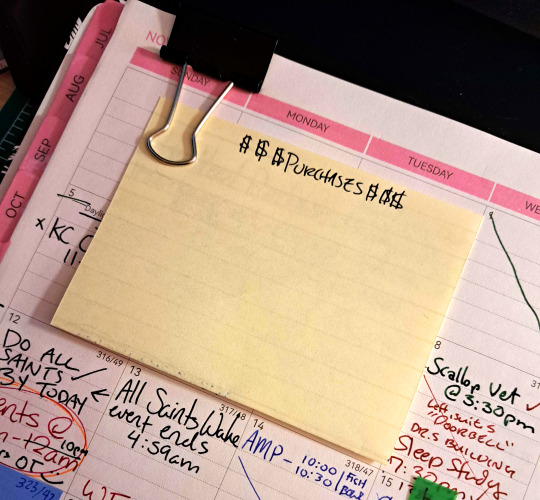
(Please excuse my mess...I'm moving into a Hobonichi Cousin for 2024, and figuring out my process in this cheap planner in the meantime!)
✒ OTHER TIPS
Pick a notebook you like! Paper smoothness, paper thickness, size, lined, dotted, gridded, etc.
Use a writing utensil you enjoy! Rollerball, fountain pen, sharpies, pencil, whatever!
Think of it as a sensory experience when it comes to the above. If you enjoy the act of it, you’re more likely to do it!
If you are able to carry around two differently-colored pens, use one to underline/add contrast for readability.
Use a paperclip to keep your place.
If you have it available, use sticky notes for tentative plans that aren’t set in stone yet.
You ARE allowed to tear pages out, cut them, modify the cover, etc. NO RULES! It's your spce.
You can prevent bleedthrough to other pages by keeping a thin, paper-sized object behind your page. (Like shitajiki/pencil boards)
✒ CONCLUSION
The main point behind EVERYTHING I’ve written here is that digital tools aren’t for everyone. Notion, Obsidian, Trello, etc. are great resources, and there are many people who have great success when using them. However, I am sure there are many other people like my partner and I who have developed a kind of “clutter blindness” to things that aren’t immediately in front of them.
You aren’t stupid for needing things broken down into exact, detailed steps. You aren’t inherently irresponsible because you miss deadlines or misplace important information. You need accessibility. The world may not be built for people like us, but there are so many ways you can learn to help yourself achieve your goals
(Please feel free to add your ideas and modifications to this post! I'd love to see what your methods are-- perhaps they might help me, as well!)
12 notes
·
View notes
Text
I officially have an access card for the lab I’m working in!! It’s so fancy!!! I’m a real professional!!!! I have a lab access card!!!
#technically we’re still waiting on security to enable access on it lol#but I still have it and will be bragging about this for the rest of my life#also it says my real name and that’s just very exciting#chemical biology#biology#stem#stemblr#uni student#university#chemistry#studyblr#chemblr#dna#dnazymes#dna aptamers#nucleic acids#functions nucleic acids#trans#transgender#transfem
2 notes
·
View notes
Text
to everyone that wants to read a research article/paper but it's been restricted, loves, use sci-hub. (https://sci-hub.se/) . just enter the doi number and you'll be able to access it and download it for free. it's truly a lifesaver, so have fun reading <33.
pm me if you can't access the link, and I'll send it to you :))
#i'm a firm believer that gatekeeping access to research paper is complete bs#also i think the founder of this website is a turkish women??#so slay of her tbh#college resources#resources#research help#important stuff!#studyblr
7 notes
·
View notes
Text
Anyone else can't access the 'website' page of their blog? The link is automatically changing to the tumblr.com/a-study-... link. Is it another shady thing Tumblr is doing to make me buy a domain?
4 notes
·
View notes
Text
About My Stenograph Machine
I thought I'd share some information on the equipment I use for stenography.
This is a very long post with several images (with image descriptions), technical explanations, and two videos attached. Thank you for reading, if you do!
I learned a lot about my machine after delving into the manual and trying to explain what I read, so I hope you do, too.
Note that while I am heavily biased towards stenograph machines, there are hobbyist keyboards made for steno that are much cheaper and readily accessible. If you would like to learn more, please click this link.
This is a Stentura 400SRT.
It's an older electric stenograph machine model, refurbished for student use.

[Image description: Photo of an electric Stenograph Stentura 400SRT Paperless Student Writer. The Stenoworks logo watermark is at the bottom left of the image. At the top of the machine are the black Platen Roller and the Paper Feed Roller. Below that is the cover/nameplate. An on/off switch and two indicator lights are at the top right of the nameplate. The first is green. Its label is to the left: a long line, with five dashes below it. Below the green indicator is a red indicator. Its label, to the left, reads: "DATA TRAN". Below the lights and switch are the words: Stentura 400SRT electric. Below that, the word Stenograph. Directly below the nameplate, on the left and right, are two horizontal Cover Release Levers. Even further below is the Stentura keyboard. At the top is a long bar called the number bar. Below that are 22 keys. At the lower left of this image is the Stenoworks watermark.]
It plugs into an outlet to keep power, has a removable battery, and uses a serial to USB adapter cable to connect to my computer. It's pretty old but sturdy and quite reliable.
The Front of the Machine
The cover of the machine, also called the nameplate, can be lifted up for further inspection and maintenance of the internal mechanisms. It also has a power switch and two indicator lights, one in green and one in red. Both flash or light up when set to different modes. If you wish to know more about the machine's various modes, please click this link to read the manual.
Below the cover are the keys of the machine.
Stenograph machines do not have the keys labeled in any way. This is to prevent writers from looking down at their hands when writing. Looking down at your hands while writing will ultimately slow you down, preventing you from reaching high speeds. This is sorta like how touch-typing is considered a faster way to type than looking down at your keyboard.
I will write a post summarizing the keys of the machine at some other point. Just know that each key doesn't represent individual letters but instead sounds, and that each stenograph machine has 22 keys plus a number bar. The keys at the far left and the middle of the machine are actually each one key, just with the appearance of being split in half.
The Bottom of the Machine
This part is not pictured, unfortunately. This is the area where you would install your external battery pack and your tripod.

[Image description: Photo of a stenograph machine tripod.]
Above is an example of a tripod. The underside of the machine has a hole for attachment. This lets you write with the machine between your legs rather than with it sitting on a desk.
My model also has a wire bar at the bottom used for writing at a desk or table while standing called the "Bench Conference Stand". This is typically used for bench conferences, wherein the plaintiff and defendants' team will speak with the judge but exclude the jury and anyone else besides the court reporter from overhearing.
The Paper Tape Mechanism
Pictured below, the top of the machine isn't something I personally use. According to the manual, the silver bar and attached lined roller are called the "Paper Feed Roller" and the black roller it's grazing is called the black "Platen Roller". You might have already guess it, but this mechanism is used to print ink on what is called "paper tape".

[Image description: Close-up of the top of the Stentura. Middle of the image is the black Platen Roller and the Paper Feed Roller.]
Paper tape is just a very long sheet of paper you would use, before the task was automated using computers, to record your stenography notes. Stenographers would typically read directly from the paper in order to prepare transcripts or when asked to repeat, in verbatim, something that had been said in court.

[Image description: Photo of the back of the Stentura. Top, centermost part of the machine are the Paper Feed Roller, Platen Roller, and the paper apron. Below that is where you would, presumably, attach the paper tray. Bottom left of the machine is the 9-pin Communications port. On the bottom right, a hole for plugging your machine into an outlet. The Stenoworks website watermark is at the bottom left of the image.]
The above is a photo of the back of the machine. Underneath the paper feed roller is a barely visible silver landing strip called a silver apron.
On the bottom left is a 9-pin Communications port. You use that to connect the writer to your computer.
Then to the far right is a hole for connecting your machine into a power outlet.
In case you're curious as to how add paper tape to a stenograph machine, below are the steps:
Attach a paper tray to the back of your machine
Add paper to the tray
Take the top-most fold
Thread the paper between the black roller and the silver apron
Roll the black roller to "feed" the paper tape into it
When the paper comes up through the top of the roller, lift up the silver paper feed roller
Place the end of the paper coming up through the top underneath the paper feed roller
Pull the paper out a few inches
Place the top of the paper tray beneath the paper
For a video representation of these steps, below is someone adding tape to their own machine:
youtube
[Video description: A stenographer giving instructions and demonstrating how to load paper tape into their stenograph machine.]
Each depression of the keys, called a stroke, would print a letter or group of letters onto the tape. Below is what the paper tape's printout would look like using Plover's paper tape plug-in. The chords here spell out "hello world".
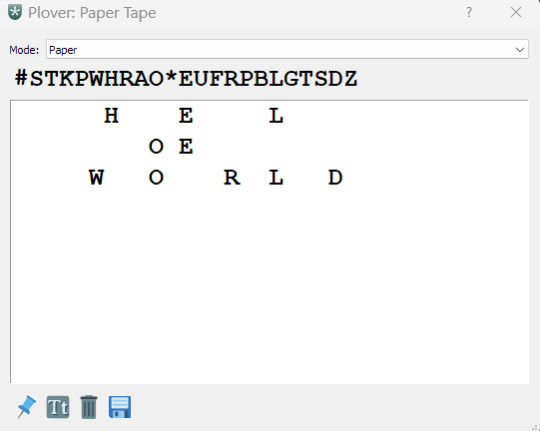
[Image description: Screenshot of the Plover paper tape plug-in. Top of the window has the Plover icon, which is a white asterisk on a green key. The window name is "Plover: Paper Tape". To the far right of the window name are the help (?) and cancel/exit (X) buttons. Below the window name is a drop-down menu labeled "Mode:". "Paper" mode has been selected. Below that is a line of the keys from the machine. The keys are: # S T K P W H R A O * E U F R P B L G T S D Z. Below that, in a white text box, are the following chords: H E L, O E, and W O R L D, each set on separate lines. At the very bottom of the window are four icons: a push-pin for pinning the window above other windows; a button with a capital and lowercase T for editing the font appearance; a garbage can for deleting what is on the paper tape; and a floppy disk for saving what you've written to the tape as a text file.]
The Longest Section: Inside the Machine
Below is an image of the internals of the stenograph machine.
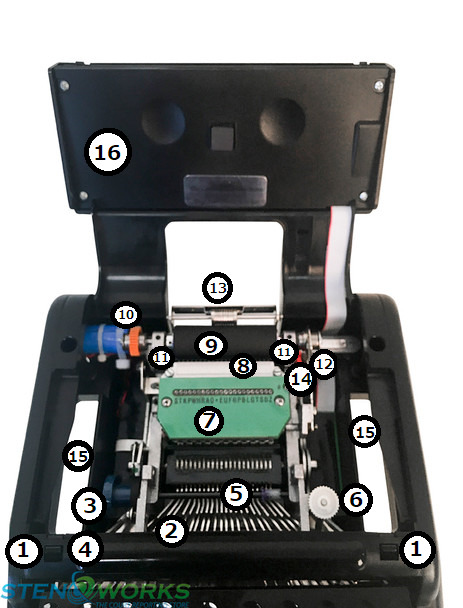
[Image description: A photo of the inside of a Stentura 400SRT. All the parts that I could identify are labeled with a number. The parts are numbered from 1 to 17 in black text on top a black circle with a white outline. The Stenoworks website watermark is in the bottom left of the image.]
All the parts that I could identify with the manual are labeled with a number. After trying to write the image description for it, I decided that I should provide the names for each part below, then separately explain what each part is or does.
Parts Labeled
Cover Release Levers
key levers
blue Ribbon Advance knob
an unpictured red knob called the Depth of Stroke knob
an empty space where the Ribbon Cartridge would be installed when using paper tape
white Keystroke Pressure knob
green strip overlay with key adjustment screws
number bar lever
black Paten Roller
orange Platen Drive Gear
Platen Bearings
Manual Platen Advance Linkage
silver Paper Feed Roller
red Electric/Manual mode lever
machine handles
Cover/nameplate
An Explanation of Each Part
The first two things labeled in the image are the Cover Release Levers. You lift those horizontal bars/levers to release the cover and lift it up to reveal what's underneath. Then there are what I presume are just called the key levers.
Following that is the blue Ribbon Advance knob.
From what I understand after fiddling with the machine, each key depression and release causes this blue knob to automatically advance number 5, the ribbon cartridge, which typically contains a self-inking, continuous loop ribbon. This ensures the machine will continue to apply ink to the paper tape with every rotation.
Not pictured is a red knob called the Depth of Stroke knob.
You turn the wheel upward or downward to adjust how far down the keys go when you press them. There are ten settings available. Adjustment also lets you decrease or increase spacing.
To the far right of the blue Ribbon Advance knob is number 6, the white Keystroke Pressure knob.
Turning it lets you adjust the amount of pressure needed to press the keys.
Above where the ribbon cartridge would be, I think, is number 7, the key contact assembly.
The green overlay strip has all the keys of the machine labeled with corresponding screws above each one, called contact adjustment screws.
The number bar's screw is to the top-right of the others. The two big screws on either side are for removing the overlay.
You would insert a 0.35 inch Allen wrench into a screw. Then you would turn it after determining that the corresponding key's switch is in need of adjustment.
Immediately above the green overlay is number 8, the machine's number bar's lever used for printing numbers into the paper tape.
Above that is number 9, the black Platen Roller.
To the left is number 10, an orange knob called the Platen Drive Gear.
On either side of the Platen Roller are number 11, the Platen Bearings. They are a single frame, identifiable by the holes located at the center of each side. Those holes are specifically for lube.
Number 12 is the Manual Platen Advance Linkage, which is to the bottom-right of the Platen Roller. Above the Platen Roller is number 13, the Paper Feed Roller. Below that, not pictured, is the silver paper apron.
All these parts work in tandem to smoothly apply ink to the paper tape when a key is depressed, and then to advance the paper to the next available line when a key is released.
If you were using the Stentura with paper tape and an ink cartridge, you would also have to apply StenoLube1 to the Platen Bearings and Platen Drive Gear, and StenoLube2 to the Paper Feed Roller.
To the right of the Platen Roller is number 14, the red Electric/Manual lever.
You would typically change from one mode to the next when either trying to make adjustments to the machine's keys or when your machine is running low on battery and you have to switch to writing on the paper tape.
Number 15 looks like it's labeling two empty areas, but those are the handles for the machine. And of course, above all of these parts is number 16, the lifted cover/nameplate.
Keystroke Emulation
As you can see, each stenograph machine is a lever-based machine, just like a typewriter. Each key on the machine connects to an electronic switch.
After completing a stroke, the machine will send that input through the real-time cable connected to your computer. Software -- Plover or CAT (Computer-Aided Transcription) -- will emulate that stroke and translate it from shorthand into something else, presumably English or a command, using a dictionary.

Above is a screenshot of the Plover Dictionary Editor. You can filter by strokes or by translations. You use this pop-up to edit, add, or delete strokes from the dictionary. All Plover users are given a pre-named dictionary called "user.json".
Rather than editing the "main.json" dictionary, which is a free user-created dictionary distributed through downloading the program, you would typically make changes to other dictionaries, especially user.json. This is to ensure that if Plover were to be updated even if your main.json were to be accidentally overwritten, you would not lose your dictionary changes.
Production of a Chord
Below is an attempt I made on December 25th, 2022, to write the top 100 English words using a metronome set to 140 bpm.
The bottom right corner of the video shows the digital paper tape emulated by Plover. Each stroke is then translated into English, as demonstrated by my completion of the drill at the center of the video.
youtube
[Video description: A video of my screen as I write to a Top 100 English Words drill on the website Stenojig. It begins with me setting a metronome to 140 bpm with stress on the 2nd of the 2 beats. In the top right is a WPM plug-in measuring my speed; on the lower right is a plug-in displaying emulated paper tape. Soon after setting the metronome, I switch tabs to Stenojig and begin the exercise. Green highlight indicates whether I've written a word correctly. And the end of the video are a set of stats indicating that I did not erase anything during the practice session, I averaged 2.15 strokes per second, and that it took me 0:47 seconds to finish the exercise, giving me an approximated WPM of 114. Then the video ends.]
#stenography#steno#open steno project#plover#education#court reporting#stentura#stenograph#stenographer#transcription#studyblr#accessibility#keyboarding#infodump#steno resources#long post#munchlax's musings
20 notes
·
View notes